
| Palaeos |  |
Metazoa |
| Metazoa | Bilateria-1 |
| Page Back | Unit Back | Unit Home | References | Glossary | Pieces |
| Page Next | Unit Next | Life | Dendrogram | Taxon Index | Time |
Metazoa |--Porifera (paraphyletic?) `--+--Radiata `--Bilateria |--Deuterostomia `--Protostomia |--Ecdysozoa `--Lophotrochozoa |
Introduction Building Bilateria The Problem of Middle Earth Trees in the Entwood "Where Many Paths and Errands Meet" References |
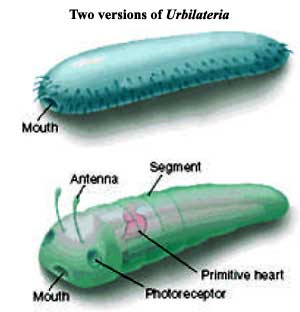 This category includes all Metazoa with bilateral symmetry (having a definite front and rear, and left and right body surfaces), either in their adult stage or (in the case of
types with secondary radial symmetry, such as echinoderms) in the larval stage. Many bilaterian animals exhibit cephalization, which is the evolutionary trend toward concentration of sensory structures, mouth, and nerve ganglia, at the anterior end of the body. This body type is
related to the further elaboration of
hox genes
This category includes all Metazoa with bilateral symmetry (having a definite front and rear, and left and right body surfaces), either in their adult stage or (in the case of
types with secondary radial symmetry, such as echinoderms) in the larval stage. Many bilaterian animals exhibit cephalization, which is the evolutionary trend toward concentration of sensory structures, mouth, and nerve ganglia, at the anterior end of the body. This body type is
related to the further elaboration of
hox genes
All bilaterians are triploblastic, which means they develop three germ layers during embryonic development. The three germ layers are
Note that only Bilateria have a mesoderm.
Bilateria is defined by reference to a hypothetical organism, Urbilateria, who was the last common ancestor of Deuterostomia (echinoderms and the various chordate phyla) and Protostomia (all other "higher" animals). Classically, these two groups were said to differ in a number of respects. Some of these characteristics have been challenged recently, but they remain generally true:
|
Update (April 2007): A number of papers published in the last few years have made it clear that the whole traditional concept of Bilateria is probably mistaken. Bilateria supposedly have three unique features: (1) bilateral symmetry, (2) hox gene patterning of the anteroposterior axis, and (3) mesoderm. It turns out that developing cnidarians clearly have (1), probably have (2), and may even have (3). It seems even more likely now that the Cnidaria are paraphyletic. That is, all of us bilaterian animals are just jellyfish who happened to use a particular type bilateral symmetry and used the hom genes in a particular way. This may have important phylogenetic implications. We cannot assume that any bilateral organism with a couple of the usual hom genes is inside the crown group of Bilateria. Consequently, the predictions we made last year (see end of this essay) about Metazoan phylogeny are looking good. Most of this is covered in Brooke & Holland (2003), which we cited -- but obviously didn't pay enough attention to. To see how far things have progressed at this point, see Ryan et al. (2007). ATW070404 |
One important difference involves the cleavage patterns; the division of cells in the early embryo. Protostomes are characterized by a spiral (the planes of cell division are diagonal to the vertical axis of the embryo) and determinant (the goal of each embryonic cell is established very early) cleavage. Deuterostomes undergo radial (parallel or perpendicular to the vertical axis of the embryo) and indeterminate cleavage (each early embryonic cell retains the capacity to develop into a complete embryo if isolated from other cells). But see, Halanych (2004); Hejnol & Schnabel (2004).
There is a strange symmetry in the fate of the blastopore (the first opening of the archenteron which forms during gastrulation.). In Protostomes ("mouth first") the blastopore forms the mouth; in Deuterostomes ("mouth second") - blastopore forms the anus.
Another difference involves how the mesoderm surrounds the body cavity. It can either pouch off or split entirely. In Schizocoela or Protostomia, it splits. In the Enterocoela or Deuterostomia, the mesoderm (or archenteron, the original gut) pouches off.
 In general terms, it isn't hard to map out the place of the Bilateria in
the scheme of things. The first "animals" were probably
uninteresting hollow balls of cells closely related to the living
choanoflagellate colonies and -- somewhat more distantly -- to the Fungi.
These aggregates were clonal. That is, they all derived from a single
parent cell, and might be thought of as a single organism. Since
maintaining a hollow ball geometry is trickier than it sounds, the first animals
became adept at manipulating cell-cell interactions, which naturally led to the
ability to specialize different parts of the "body." After a
bit, some deviant globe of cells developed the ability to create new globes and
attach them to the original ball. After a few more million years of experimentation, the result was the
Porifera, the sponges, which often have no
particular shape, but have a respectable degree of specialization within small
subunits.
In general terms, it isn't hard to map out the place of the Bilateria in
the scheme of things. The first "animals" were probably
uninteresting hollow balls of cells closely related to the living
choanoflagellate colonies and -- somewhat more distantly -- to the Fungi.
These aggregates were clonal. That is, they all derived from a single
parent cell, and might be thought of as a single organism. Since
maintaining a hollow ball geometry is trickier than it sounds, the first animals
became adept at manipulating cell-cell interactions, which naturally led to the
ability to specialize different parts of the "body." After a
bit, some deviant globe of cells developed the ability to create new globes and
attach them to the original ball. After a few more million years of experimentation, the result was the
Porifera, the sponges, which often have no
particular shape, but have a respectable degree of specialization within small
subunits.
The really difficult part came next -- body-level organization. How exactly this was accomplished we won't even guess, at least not right now, since it would be off-topic. The bottom line is that the ball of cells continued to grow, rather than budding new cell aggregates. Since a soft, hollow sphere is not an easy shape to maintain without collapsing, it promptly collapsed. However, it did so in a very interesting and specific way. The maneuver involved creating an inner pocket, as shown in the image. By geometrical necessity, this creates a population of "inside" cells in addition to the original "outside" cells, and a more or less circular boundary region. This is pretty much all we need to create the hydra body plan of a cnidarian a (sea anemone or jellyfish). This is also exactly what happens in the early development of all animal embryos, during the gastrula phase, which is why we have used embryological terminology to label the parts in the diagram from Technau & Scholz (2003).
Ernst Haeckel (1834-1919), whose many accomplishments included looking just exactly like Gandalf the Grey, was the first person to recognize this striking parallel between early animal development and the probable course of early animal evolution. He called his idea the Gastraea Hypothesis, and it is the real source of Haeckel's "Law" that "ontogeny recapitulates phylogeny." This was, and remains, a powerful insight -- true in many cases. It is not a "law" in the same sense as the physical laws of Kepler or Newton. Like many biological "laws," it is, instead, a recurring pattern. It may not apply in any given case, but it happens often enough that it ought to be the default hypothesis until something better comes along. However, in the case of early metazoan evolution, nothing better has come along even now, more than 100 years after Haeckel's time. So, the next time you hear someone belittle Haeckel (as it has become fashionable to do), remind them of this remarkable insight. Ask them if they have a better idea.
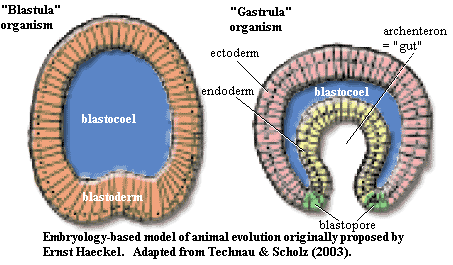 Actually, there are a number of topologically reasonable ways to create an
inner compartment, and most can be found within the embryological diversity of
the Cnidaria and Ctenophora. All such methods create endoderm and
ectoderm, but the gastrula maneuver creates a critical ring-shaped boundary area
where ectoderm and endoderm meet. It isn't clear yet why this should have such importance, but it plainly does. In cnidarians, this is the
mouth or hypostome. It is the most specialized region of the body,
and around it develop the other specialized structures, particularly the
tentacles and a large proportion of the sensory cells. This area is clearly a critical link, but extraordinarily
hard to understand, as we will discuss later.
Actually, there are a number of topologically reasonable ways to create an
inner compartment, and most can be found within the embryological diversity of
the Cnidaria and Ctenophora. All such methods create endoderm and
ectoderm, but the gastrula maneuver creates a critical ring-shaped boundary area
where ectoderm and endoderm meet. It isn't clear yet why this should have such importance, but it plainly does. In cnidarians, this is the
mouth or hypostome. It is the most specialized region of the body,
and around it develop the other specialized structures, particularly the
tentacles and a large proportion of the sensory cells. This area is clearly a critical link, but extraordinarily
hard to understand, as we will discuss later.
The hydra body plan, described above, lacks two important elements which are shared by all Bilateria, i.e., Protostomia (bugs, worms, clams, etc.) plus Deuterostomia (sea urchins, people, etc.). These were mentioned in the introduction: (1) mesoderm and (2) bilateral symmetry. Mesoderm is a third embryological "germ layer" (fundamental cell type) which develops in the blastocoel after gastrulation. There are several different ways in which mesoderm is produced, which tend to differ between protostomes and deuterostomes. In general, mesoderm formation appears to be based on a key transcription factor coded by the regulatory gene brachyury. We go into this in excessive detail below. The evolution of bilateral symmetry is actually the more difficult development to explain, and we have no easy answers.
The net result of all this reconstruction is a sort of short, worm-like animal with a mouth (but not necessarily an anus), a primitive gut, a specialized area around the mouth with a tendency to develop sensory structures, mesoderm (and, so, probably some internal specializations such as body wall muscles), and bilateral symmetry. That, folks, is Urbilateria.
Urbilateria the ur-bilaterian, the last common ancestor of Attila the Hun and Atta the ant, is a rather critical player in our story because of the way we have defined our clades. As a reminder, the bare bones of our working phylogeny looks like this:
Metazoa (animals) = [toads > toadstools]
|--Porifera (sponges)
`--+--Cnidaria (anemones, jellyfish, etc.)
`--BILATERIA = [men + mollusks] = Urbilateria and all of its descendants
|--DEUTEROSTOMIA = [men > mollusks]
`--"Middle Earth" (paraphyletic)
`--PROTOSTOMIA = [bugs + slugs]
|--Ecdysozoa = [bugs > slugs]
`--Lophotrochozoa = [slugs > bugs]
|--Annelida
`--Mollusca
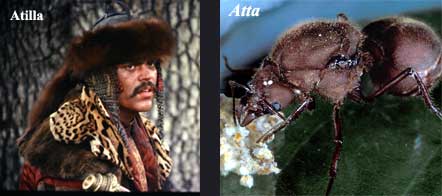 Bilateria
is a crown group. It is defined as the extended family of the last common ancestor of men and
mollusks, or Attila and Atta if you prefer. In short, it consists
of Urbilateria and all of its descendants. Since it is a crown
group, it has two branches, one leading to men and the other leading to mollusks. Deuterostomia is a stem group, defined to take in everything
more closely related to men than mollusks. That is, it takes up all
of the branch of Bilateria leading toward humans. However Protostomia is not
a stem group. It is another crown group, defined by the intersection of
bugs (Ecdysozoa) and slugs (Lophotrochozoa). Therefore, there is a gap of
unknown size and composition between Urbilateria and Protostomia
containing animals which are bilaterians, but neither deuterostome nor
protostome. We have labeled this part of phylospace "Middle
Earth," since it may be completely mythical, or quite real and filled
with all manner of unfamiliar creatures. In order to get a handle on
Bilateria, the challenge is to
find out if Middle Earth exists and, if so, who lives there. That, in turn, may depend on what characteristics Urbilateria
might have had.
Bilateria
is a crown group. It is defined as the extended family of the last common ancestor of men and
mollusks, or Attila and Atta if you prefer. In short, it consists
of Urbilateria and all of its descendants. Since it is a crown
group, it has two branches, one leading to men and the other leading to mollusks. Deuterostomia is a stem group, defined to take in everything
more closely related to men than mollusks. That is, it takes up all
of the branch of Bilateria leading toward humans. However Protostomia is not
a stem group. It is another crown group, defined by the intersection of
bugs (Ecdysozoa) and slugs (Lophotrochozoa). Therefore, there is a gap of
unknown size and composition between Urbilateria and Protostomia
containing animals which are bilaterians, but neither deuterostome nor
protostome. We have labeled this part of phylospace "Middle
Earth," since it may be completely mythical, or quite real and filled
with all manner of unfamiliar creatures. In order to get a handle on
Bilateria, the challenge is to
find out if Middle Earth exists and, if so, who lives there. That, in turn, may depend on what characteristics Urbilateria
might have had.
We will use two distinct approaches to investigate the population of Middle Earth: phylogeny and embryology. The phylogenetic approach involves the usual business of comparing warring cladograms and methodologies. This approach focuses on the point where bugs and slugs diverge. Anything bilaterian, but basal to that point, is a hobbit. The embryological approach, by contrast, focuses on Urbilateria. It tends to be difficult, theoretical and often quite speculative. However, as we will see, there are excellent reasons for resorting to this sort of thing, as a check on the usual phylogenetic methods.
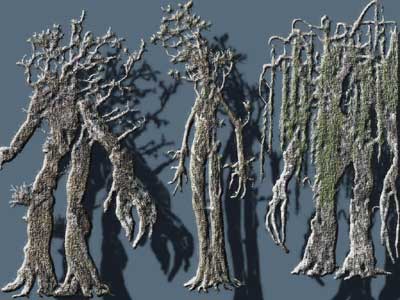 We would love to say that no one could possibly review all of the recent
literature on bilaterian phylogeny. Unfortunately several inconsiderate
show-offs evidently had nothing better to do, and have published just such
reviews, too recently to ignore. Zrzavý
(2001); Halanych (2004),
Philippe
et al. (2005). Confronted with the undeniable evidence of all
this industry, we can claim only
that no one as shiftless as we are could possibly review all of the recent
literature on bilaterian phylogeny. Nonetheless, we have dabbled in the
literature in our usual cursory manner -- at least to the extent of casually
skimming the said reviews of Zrzavý, Halanych, and Philippe et al.
We would love to say that no one could possibly review all of the recent
literature on bilaterian phylogeny. Unfortunately several inconsiderate
show-offs evidently had nothing better to do, and have published just such
reviews, too recently to ignore. Zrzavý
(2001); Halanych (2004),
Philippe
et al. (2005). Confronted with the undeniable evidence of all
this industry, we can claim only
that no one as shiftless as we are could possibly review all of the recent
literature on bilaterian phylogeny. Nonetheless, we have dabbled in the
literature in our usual cursory manner -- at least to the extent of casually
skimming the said reviews of Zrzavý, Halanych, and Philippe et al.
Fortunately, a few examples will suffice to make the relevant point. What we will find is that, while we can obtain some hints, the trees of Middle Earth often turn out to be Ents. That is, they are not fixed in place, but shift their limbs in unexpected ways, with a tendency to ensnare unwary travelers with their long branches. In short, these trees are unstable and exhibit long branch attraction.
Consider Steinauer et al. (2005). One of the problems with investigating Middle Earth is that its inhabitants are poorly known. Most candidate species are rare and/or obscure parasites. The Acanthocephala are a case in point. The acanthocephalan Leptorhynchoides is a parasite of vertebrate carnivores which looks a little like a nemertine worm with training wheels. Virtually the only persons with an interest in Leptorhynchoides are a few, notoriously single-minded, public health types whose interest begins and ends with finding new methods for making the Acanthocephela yet rarer and/or more obscure.
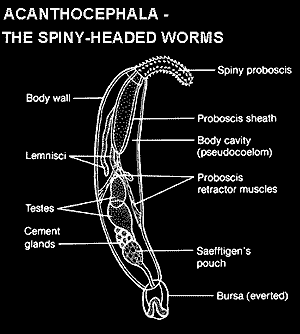 To the extent that anyone has cared at all, the understanding has been that
acanthocephalans are some kind of evil rotifer cousin (Herlyn et al.,
2003) or just some kind of evil rotifer (Zrzavý,
2001). Undeterred by considerable morphological evidence, Steinauer et al.
sequenced the entire mitochondrial genome of Leptorhynchoides. They
found many useful bits of information which, as in most mtDNA studies, they
proceeded to ignore completely (see methodological critique at Insectivora).
These workers then applied the usual sequence-based techniques to construct a
phylogenetic tree. Perversely, they failed to include any sequences from
rotifers, gnathostomulids, chaetognaths, or, in fact, anything that might
actually be comparable to Acanthocephala. They found that (a) nothing
lives in Middle Earth; (b) acanthocephalans are close to Platyhelminthes; (c) both
are mollusks; and (d) that long branch attraction might have played a part in
the results.
To the extent that anyone has cared at all, the understanding has been that
acanthocephalans are some kind of evil rotifer cousin (Herlyn et al.,
2003) or just some kind of evil rotifer (Zrzavý,
2001). Undeterred by considerable morphological evidence, Steinauer et al.
sequenced the entire mitochondrial genome of Leptorhynchoides. They
found many useful bits of information which, as in most mtDNA studies, they
proceeded to ignore completely (see methodological critique at Insectivora).
These workers then applied the usual sequence-based techniques to construct a
phylogenetic tree. Perversely, they failed to include any sequences from
rotifers, gnathostomulids, chaetognaths, or, in fact, anything that might
actually be comparable to Acanthocephala. They found that (a) nothing
lives in Middle Earth; (b) acanthocephalans are close to Platyhelminthes; (c) both
are mollusks; and (d) that long branch attraction might have played a part in
the results.
We can certainly endorse the last conclusion. If a group of DNA sequences are similar, one can sometimes create a valid phylogenetic tree by comparing the changes at homologous sites. Over time, however, the same site will have changed multiple times. The nucleotide found at the site becomes randomized and carries no valid phylogenetic signal. See discussion at Insectivora. The relevant time frame varies with the site, the species, and by blind luck. Consequently, when one is comparing sequences which diverged long ago and are quite different ("long branches"), the phylogenetic signal is swamped by random noise and by other, non-phylogenetic, effects, giving rise to all kinds of spurious results. This is called "long branch attraction." Unfortunately, long branch attraction actually becomes worse as more data are added to the matrix. Philippe et al. (2005). This effect may be analogous to a subtle problem related to missing data in morphological work. See discussion at Pythonomorpha. However, contrary to a wrong, but oft-repeated, scientific fable, morphological parsimony methods are generally much less subject to this source of error. Siddall & Whiting (1998).
For reasons we really ought to discuss one day, small, parasitic organisms tend to mutate a lot faster than others. Most of the possible inhabitants of Middle Earth are just such organisms and are known to mutate faster than a comic book superhero. Lavrov & Lang (2005) (nematode mtDNA "statistically indistinguishable from randomly shuffled genomes with the same gene content") Thus these organisms quickly reach branch lengths at which any phylogenetic signal is overwhelmed by noise.
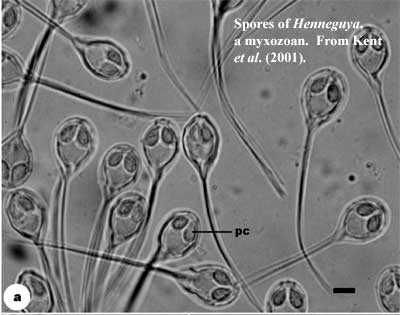 Treehugging
Treehugging
In the last few years, a number of groups have attempted various strategies to confine these phylogenetic Ents. While they have had somewhat more success than Sauruman the White, the results have been unsatisfactory.
Lavrov & Lang (2005) used the promising technique of comparing mitochondrial gene order (not sequence); but they were forced to eliminate taxa with unacceptably high rates of branch growth. They obtained believable results, but resolution was poor and all of the likely inhabitants of Middle Earth had to be pruned to make their approach work. Much the same might be said of Philippe et al. (2005), who use 18S rRNA sequences. Both recognize the long-branch problem, attempt to deal with it, and recover reasonable trees -- but with very little phylogenetic resolution and no information on the phyla of interest to us.
A more productive approach may be that of Ruiz-Trillo et al. (2002), who used one of the myosin genes to map bilaterian phylogeny. Myosin is one of the critical contractile proteins of all metazoan cells -- and almost all eukaryotic cells. The reasoning, which seems to have been sound, was that myosin is under more or less uniform structural constraints and ought to evolve both slowly and regularly. The authors conclude that acoel worms and nemertodermatids (collectively, the Acoelomorpha) are basal to the rest of the former Platyhelminthes which are protostomes. The only difficulty is that the Acoelomorpha also end up basal to the crown group Bilateria! As it turns out, this is entirely possible. See discussion of Cook et al. (2004), toward the end of all this noise. Nevertheless, Ruiz-Trillo et al. (2002) requires no panic-driven redefinition of the Bilateria. We certainly thought about it, but soon stopped screaming (when we ran out of breath). Restored to our customary state of cheerful pomposity, we set about the serious business of making excuses. Fortunately, the branch order of a number of the major clades seems to be slippery in this study. Accordingly, we can't take it as solid authority that Acoelomorpha has fallen right out of Bilateria.
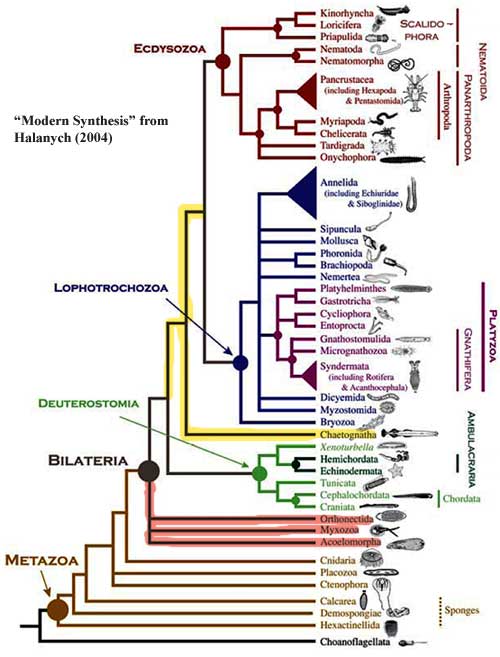 Halanych
(2004) has attempted to summarize those results in the figure reproduced
here. However, it is unclear what definition he is applying to
Bilateria. In our scheme, there are only three kinds of Bilateria:
deuterostomes, protostomes and hobbits (stem protostomes -- the yellow lines in
the figure). Since Halanych supplies no phylogenetic definition, we
were forced against our will, and with much gnashing of teeth, rending or
garments, etc., to consult the primary sources for the three groups marked with
red lines.
Halanych
(2004) has attempted to summarize those results in the figure reproduced
here. However, it is unclear what definition he is applying to
Bilateria. In our scheme, there are only three kinds of Bilateria:
deuterostomes, protostomes and hobbits (stem protostomes -- the yellow lines in
the figure). Since Halanych supplies no phylogenetic definition, we
were forced against our will, and with much gnashing of teeth, rending or
garments, etc., to consult the primary sources for the three groups marked with
red lines.
As it turns out, the Orthonectida are almost certainly metazoans, particularly under our stem group definition; but it's anyone's guess whether they, or any other members of the mysterious Mesozoa, are also bilaterians. Hanelt et al. (1996). At any rate neither Hanelt's study nor any later work exclude the Mesozoa from Middle Earth. Zrzavý (2001).
The Myxozoa may well reside in Middle Earth. Monteiro et al. (2002). Zrzavý (2001) asserts that myxozoans are more primitive, but his review was written before Monteiro's report that the morphologically bilaterian Buddenbrockia is a myxozoan.
The Acoelomorpha are consist of two different phylum-level groups, the Nemertodermatida and the Acoela. Both of these groups were parts of the classical Phylum Platyhelminthes. However, molecular studies consistently separate the acoelomorphs, and the separation is plausible on morphological grounds. We will return to these candidate hobbits later. For the moment, it is enough to note that both are likely bilaterians, but either or both may be protostomes.
Finally, Halanych places the Chaetognatha right in the middle of Middle Earth. This is recent work from Halanych's own lab, and it has not yet attracted much support from elsewhere. Chaetognaths ("arrow worms") were considered to be deuterostomes until quite recently, when they were relocated to the protostomes. Possibly the thought of moving this lot yet again has inspired some resistance.
"It is a lovely language, but it takes a very long time to say anything in it."
Phylogenetic methods may ultimately be able to sort out the long branch problem by using carefully chosen, highly conserved sequences. But phylogenetic methods, particularly molecular methods, can also suffer from an opposite problem, i.e. not just long branches, but short stems. A branching pattern can best be resolved if the radiation occurs in a relatively slow and orderly way, so that each critical divergence is clearly separate from the previous one. However, Middle Earth was being populated right in the midst of the Cambrian Explosion -- arguably the most rapid series of evolutionary changes which the Animal world has ever experienced.
The Molecule Mob have always argued that the Cambrian Explosion did not exist, and that the actual divergences occurred deep in the Neoproterozoic. However, if that were the case, as some of the Moleculons now admit, these tree-building methods ought to work much better than they in fact do. Rokas et al. (2003).
Indeed, Rokas et al. (2005) have now turned the argument on its head. They make a fairly convincing case that the failure of sequence-based methods to reconstruct the tree at this point in time tends to prove the existence of a Cambrian Explosion. They point out that, if the Explosion did occur, and if it lasted significantly less than 50 My (which is a reasonable bet on morphological grounds), even the complete sequence of the all living lineages from that event may be mathematically insufficient to reconstruct the branching pattern. In other words, it may not even theoretically possible to construct the correct tree using these methods. The fact that we cannot seem to get consistent results using these methods strongly suggests that the metazoan phyla in fact diverged within a short space of time.
Note, however, that Levinton et al. (2004), using the same theoretical framework, claim that that they have recovered the correct phylogeny using sequence methods, so that the Cambrian Explosion cannot have existed. However, the phylogeny they rely on (Wray et al., 1996) actually draws a tree of only 6 metataxa, using individual taxa and methods which are not fully described. We view this dispute with placid ambivalence, suspecting that the truth lies between the positions garrisoned by these contending forces.
| Page Back | Page Top | Unit Home | Page Next |